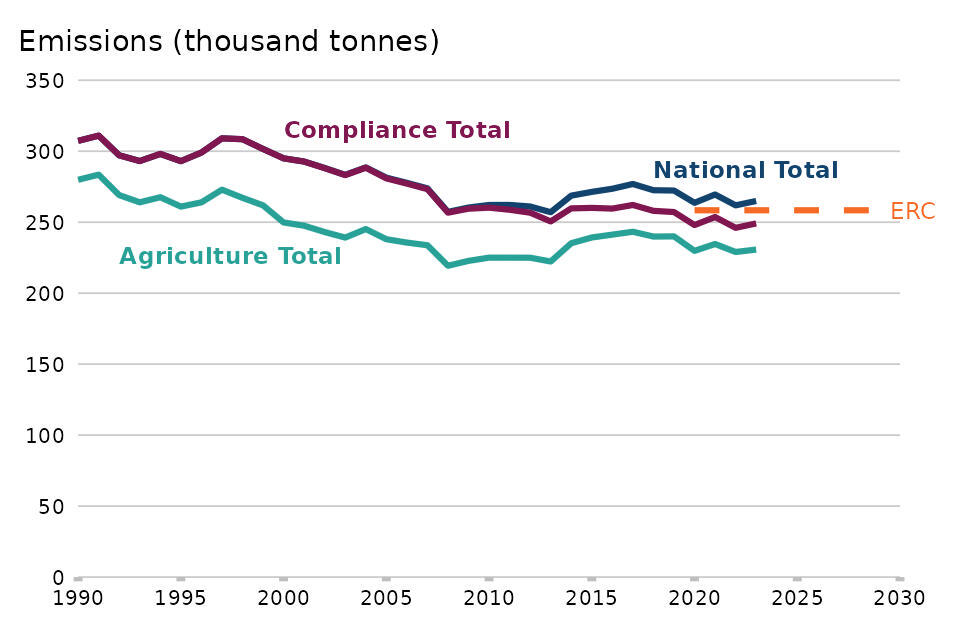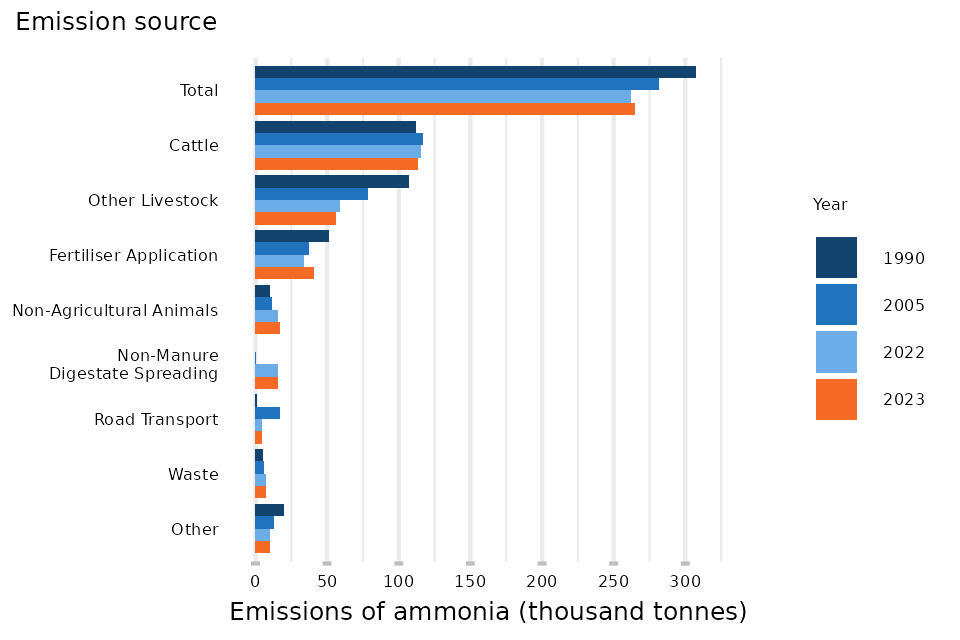Emissions of air pollutants in the UK – Ammonia (NH3)
Updated 13 March 2025
1. What is ammonia and why are emissions of it estimated?
Ammonia (NH3) is a gas that only stays in the atmosphere for a few hours once emitted. However, when ammonia mixes with other gases in the atmosphere, such as nitrogen oxides and sulphur dioxide, it can form particulate matter (PM) which can exist for several days and be transported large distances. PM formed through this process are classed as secondary pollutants and therefore it is not included in the PM emissions estimations reported in this release. However, there are major health concerns linked to exposure to PM concentrations. Therefore, estimating ammonia emissions is important to help us understand how much secondary PM derived from ammonia contributes to the concentrations.
Deposition of chemical compounds containing ammonia to the environment can also cause significant long-term harm to sensitive habitats by increasing nitrogen concentrations in soil or water. When soil nitrogen levels increase, common plant species that thrive in these conditions can dominate habitats at the expense of other rarer species. This can result in major changes to plant community structure (e.g. affecting the composition and diversity of plant species) which affects associated animal species. Ammonia is also directly toxic to plants and some species of moss and lichen are impacted even at very low concentrations.
The vast majority of ammonia emissions come from agricultural sources, in particular livestock manure, urine and the spreading of inorganic fertilisers. A small portion of ammonia emissions stem from waste and a range of diffuse sources (i.e. wide geographical spread and large variety of emission sources, ranging from composting to domestic pets).
The National Atmospheric Emissions Inventory (NAEI) and the statistical tables published as part of this release mostly cover ammonia emissions from human activities in the UK, but there are a few exceptions included as memo items, such as emissions from the wastes of wild birds. The national totals referred to in this document only relate to ammonia emissions from human activities in the UK.
The revised Convention on Long Range Transboundary Air Pollution’s amended Gothenburg Protocol (CLRTAP) and National Emission Ceilings Regulations (2018) (NECR) require the UK to reduce ammonia emissions by 8 per cent compared to emissions in 2005 by 2020 and in each subsequent year up to and including 2029. The NECR also requires the UK to reduce ammonia emissions by 16 per cent compared to emissions in 2005 by 2030.
2. Trends in total annual emissions of ammonia in the UK, 1990 to 2023
Figure 8: Annual emissions of ammonia in the UK: 1990 to 2023

Notes:
- ‘2020-2029 ERC’ refers to the UK’s 2020-2029 emission reduction commitment, set out in the National Emission Ceilings Regulations (2018) and the ‘2020 and beyond’ emission reduction commitment, as set out in the Convention on Long Range Transboundary Air Pollution. This applies to the series labelled ‘Compliance Total’.
View the data for this chart (years available: 1980-2023)
Download the data for this chart in CSV format (years available: 1980-2023)
Emissions of ammonia have decreased by 14 per cent since 1990, to 265 thousand tonnes in 2023. The majority of this reduction occurred between 1990 and 2008. Emissions of ammonia then remained relatively stable from 2008 to 2013. Annual ammonia emissions reached the lowest in the time series in 2013 at 257 thousand tonnes. Since then, emissions have been higher, but have remained below the levels seen prior to the mid-2000s. Changes in the trend of emissions of ammonia are largely driven by changes to farming practices and herd sizes.
Emissions from agriculture contributed 87 per cent of total ammonia emissions in 2023. Emissions have increased slightly from 225 thousand tonnes in 2010 to 231 thousand tonnes in 2023, although emissions have generally fluctuated throughout this period. Recent changes in emissions have been in part driven by annual variations in weather conditions affecting crop planting and fertiliser use, as well as energy prices affecting the use of fertilisers.
For compliance purposes annual total emissions of ammonia are adjusted by removing the contribution of emissions from non-manure digestate spreading from the whole time-series (see Background section for more information). Considering the adjusted total for compliance, there were 249 thousand tonnes of ammonia emitted in the UK in 2023. Therefore, emissions decreased by 11 per cent since 2005 and the UK is compliant with both the NECR and the CLRTAP 2020-2029 emission reduction commitments.
3. Major emission sources for ammonia in the UK
Figure 9: Annual emissions of ammonia in the UK by major emission source: 1990, 2005, 2022 and 2023

Notes:
-
‘Cattle’ refers to both dairy and non-dairy cattle; ‘Other livestock’ refers to poultry, pigs, sheep, goats, deer and agricultural horses; and ‘Non-Agricultural Animals’ refers to domestic pets and non-agricultural horses.
-
‘Fertiliser Application’ refers to the application of inorganic fertilisers to agricultural soils, including urea and ammonium nitrate. This does not include the spreading of livestock manure, sewage sludge or digestates.
-
‘Non-Manure Digestate Spreading’. Non-manure digestates are produced from the anaerobic digestion of non-manure feedstocks (food waste, energy crops and crop residues and other organic residues) and are spread as fertiliser onto agricultural soils. This does not include the spreading of manure digestates, which are captured within emission estimates for livestock.
-
‘Waste’ includes composting, landfill, sewage sludge decomposition and waste incineration.
-
‘Other’ includes all other sources, such as sewage sludge application to soils, and domestic and industrial product use.
Download the data for this chart in CSV format
Most agricultural ammonia emissions derive from livestock, most notably from the decomposition of urea in animal wastes (and uric acid in poultry wastes). Emissions from livestock derive from the management of manure, the application of manure to soils and manure-based digestate spreading. Emissions from livestock also come from urine and dung deposited in housing, on yards and when grazing.
Cattle are the largest source of ammonia, accounting for approximately two thirds of all emissions from livestock in 2023 and 43 per cent of total ammonia emissions. Emissions from cattle have remained between 110 and 119 thousand tonnes across the last 30 years. Emissions from dairy cows have risen over the past decade, while emissions from other cattle have fallen. Poultry are the next largest emitting livestock group followed by pigs, sheep, horses, deer and goats. The fall in emissions from livestock other than cattle, especially from the pig and poultry sectors, is the main driver in the gradual fall of overall ammonia emissions since 1990. This can be partly explained by the Pollution Prevention and Control Act (1999) making all new intensive pig and poultry installations subject to ammonia controls through permitting.
The spreading of inorganic fertilisers is a large source of ammonia emissions from agriculture (15 per cent of total ammonia emissions in 2023). Emissions from this source have fluctuated since estimates of emissions began, largely driven by the cost of fertilisers and the weather. Emissions from urea-based fertilisers (which emit more ammonia) have been on an upward trend since the mid-90’s, while emissions from other fertilisers have shown a downward trend. Manufacture of inorganic fertilisers is energy intensive, so their cost is linked to the cost of energy. Energy prices were high in 2021 and 2022, and this contributed to relatively low use of inorganic fertilisers compared to the previous decade. However, in 2023, there was an overall increase in emissions from inorganic fertilisers, in part due to falling energy costs decreasing the price and increasing the use of urea-based fertilisers.
Ammonia can be emitted from vehicle exhausts as a by-product of the catalytic conversion process designed to reduce emissions of nitrogen oxides. Emissions of ammonia from road transport increased up to 2000, and since then emissions have steadily decreased as new vehicle emission standards have been introduced. Road transport now represents a smaller share of total ammonia emissions (contributing 7 per cent of total emissions in 2002 and 2 per cent in 2023).
Emissions from the storage and spreading of non-manure digestates have increased substantially since 2010 when it contributed less than 1 per cent of emissions to contribute 6 per cent of emissions in 2023. Digestates are the by-product of anaerobic digestion, which is used to generate biogas from feedstocks such as manures, food waste, crop residues and energy crops. Biogas produced from waste feedstocks provides a more sustainable alternative to natural gas derived from fossil fuels. Digestates are nutrient rich and are spread as fertiliser onto agricultural soils.
Emissions from waste contributed 3 per cent of total ammonia emissions in 2023. Most emissions of ammonia from the waste sector are from composting, sewage sludge decomposition and anaerobic digestion. Ammonia emissions from landfill have fallen by 91 per cent since 1990, while emissions from composting have increased by 179 per cent since 1990, and emissions from anaerobic digestion have increased by 2588 per cent since 2009.
Emissions from domestic pets accounted for 5 per cent of total ammonia emissions in 2023. Emissions from this source have increased by 48 per cent between 2019 and 2023, largely due to increased pet ownership.
Levels and trends in emissions from specific sources are available for the period 1990 to 2023 through the statistical tables that accompany this release.
Sections in this release
Emissions of particulate matter (PM10 and PM2.5)
Emissions of non-methane volatile organic compounds
Methods and quality processes for UK air pollutant emissions statistics (PDF)
